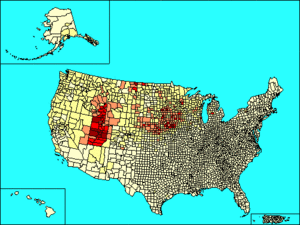Danish Americans facts for kids
| Total population | |
|---|---|
| 1,284,171 0.4% of the U.S. population (2017) | |
| Regions with significant populations | |
| California, Utah, Iowa, Wisconsin, Nebraska, Minnesota and Illinois | |
| Languages | |
| English, Danish | |
| Religion | |
| Christianity (predominantly Lutheran; also other Protestant churches, Catholicism and Mormonism) | |
| Related ethnic groups | |
| Danes, Greenlanders, Greenlandic Americans, Danish Canadians, Danish Australians, Scandinavian Americans, Norwegian Americans, European Americans |
Danish Americans (Danish: Dansk-amerikanere) are people in the United States whose families came from Denmark. About 1.3 million Americans have Danish roots. This means they are either fully or partly of Danish origin.
Contents
Who are Danish Americans?
Danish Americans are a part of the larger group of European Americans. They have brought many parts of Danish culture to the U.S. This includes traditions, foods, and ways of life. Many Danish immigrants came to America looking for new opportunities. They also sought religious freedom.
Where did they settle?
Many Danish immigrants settled in the Midwest. States like Iowa, Nebraska, Minnesota, and Wisconsin have strong Danish American communities. Utah also has a large number of Danish Americans. This is because many early Danish immigrants joined the Mormon Church. They moved to Utah to be with other members of their faith.
Why did Danes come to America?
Most Danes came to the U.S. in the late 1800s and early 1900s. They were often farmers or workers. They hoped to find good land and jobs. America offered a chance for a better life. Some also came to escape difficult times in Denmark. Others came for religious reasons.
Danish American Culture
Danish Americans have kept many of their traditions alive. They celebrate Danish holidays. They also enjoy Danish foods. Many communities have Danish cultural centers. These places help teach younger generations about their heritage.
Language and Religion
Most Danish Americans today speak English. However, some older people or those in strong Danish communities might still speak Danish. The main religion among Danish Americans is Lutheranism. This is the national church of Denmark. Other Christian faiths, like Catholicism and Mormonism, are also present.
Famous Danish Americans
Many Danish Americans have made important contributions to the U.S. They have worked in many fields. These include art, science, and sports. For example, Gutzon Borglum was a famous sculptor. He created the Mount Rushmore monument. This is a very famous American landmark. Another notable person was Battling Nelson, a well-known boxer from the early 1900s. The Barrison Sisters were also famous performers in vaudeville shows.
Images for kids
-
Gutzon Borglum sculpted Mount Rushmore.
See also
 In Spanish: Inmigración danesa en Estados Unidos para niños
In Spanish: Inmigración danesa en Estados Unidos para niños






